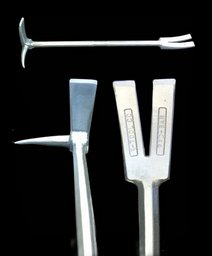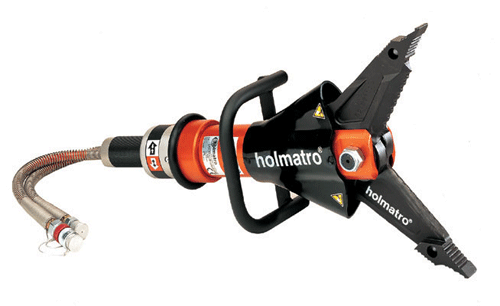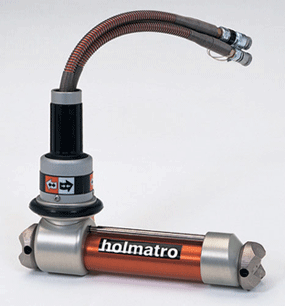

| Prying tools provide an advantage to the firefighter for opening doors, windows, locks, and moving heavy objects. Hand (manual) prying tools use the basic principle of leverage to provide a mechanical advantage. This means that when using the prying tool, a firefighter is able to generate more force on an object with the tool than without it. The correct tool must be selected first. If an object cannot be forced with one tool, a different tool should be selected. |
|
| Hydraulic prying tools can be either powered hydraulic or manual hydraulic. Powered hydraulic tools receive their power from hydraulic fluid pumped through special high-pressure hoses. Although there are a few pumps that are operated by compressed air, most are powered by either electric motors or by two- or four-cycle gasoline engines. Manual hydraulic tools are labor-intensive and operate slower than powered hydraulic tools. Manual hydraulic tools are operated by transmitting pressure from a manual hydraulic pump through a hydraulic hose to the tool assembly. | |
| A large variety of hand prying tools is available to the fire service (click on name for picture and a brief description if provided): | |
 Because the Halligan Bar is probably one of the most used tools, if not the most used tool, in the fire service, a brief descprition will be given. The Halligan Bar is a special tool commonly used in the fire and rescue service. It was designed by and named after Hugh Halligan, a First Deputy Fire Commissioner in the New York City Fire Department. The Halligan is a multipurpose prying tool consisting of a claw (or fork), a blade (or adz), and a pick, which is especially useful in quickly breaking through many types of locked doors. The adz (An edge tool used to cut and shape wood) or fork end of the tool can be used to break in through an outward swinging door by forcing the tool between the door and doorjamb and prying the two apart. Along with the K-tool and the adz or fork end a lock can easily be pulled. There are many other uses of the Halligan tool, including vehicle rescue and opening of walls. A Halligan bar and an axe can be joined together to form what is known as a married set, or set of irons. Because the Halligan Bar is probably one of the most used tools, if not the most used tool, in the fire service, a brief descprition will be given. The Halligan Bar is a special tool commonly used in the fire and rescue service. It was designed by and named after Hugh Halligan, a First Deputy Fire Commissioner in the New York City Fire Department. The Halligan is a multipurpose prying tool consisting of a claw (or fork), a blade (or adz), and a pick, which is especially useful in quickly breaking through many types of locked doors. The adz (An edge tool used to cut and shape wood) or fork end of the tool can be used to break in through an outward swinging door by forcing the tool between the door and doorjamb and prying the two apart. Along with the K-tool and the adz or fork end a lock can easily be pulled. There are many other uses of the Halligan tool, including vehicle rescue and opening of walls. A Halligan bar and an axe can be joined together to form what is known as a married set, or set of irons. |
|
A Set of Irons |
|
| Many departments have names for tools other than those names found here. Firefighter should become familiar with the types and names of the tools carried on their own apparatus. Firefighters need to be familiar with other important aspects of hand prying tools such as which surfaces may be used for striking, why are prying surfaces, etc. Efficiency in the use of a tool under emergency situations is directly affected by the firefighter's familiarity with the tool's function. Some prying tools can also be used effectively as striking tools, although most cannot. For safe and efficient use of a tool, it should be used for it intended purpose. | |
| Hydraulic Prying Tools: | |
| Hydraulic prying tools that one person can operate have proven very effective in extrication rescues. They are also useful in forcible entry situations. These tools are useful for a variety of different operations involving prying, pushing, or pulling. The rescue tools and hydraulic door opener are examples of hydraulic prying tools. | |
| The hydraulic rescue spreader, often associated with vehicle extrication, has proved to be useful in forcible entry situations. The tips on these tools may be able to spread as much as 32 inches. Their capability to exert force in either spreading or pulling makes them a valuable tool in some instances. |  |
 |
The hydraulic ram is another hydraulic rescue tool. Although designed primarily for vehicle extrication, hydraulic rams have spreading capabilities ranging from 36 inches to an extended length of nearly 63 inches. In certain forcible entry situations, these tools may be invaluable. One use of the ram is to place it between either side of a door frame to spread the frame apart far enough to allow the door to swing open. |
The hydraulic door opener is a hand-operate device that is relatively lightweight. It consists of a hand pump and spreader device. The spreader device has intermeshed teeth that can easily be slipped into a narrow opening, such as between a door and door frame. A few pumps of the handle causes the jaws of the spreader device to open, exerting pressure on the object to be moved. The pressure usually causes the locking mechanism or door to fail. These are extremely valuable tools when more than one door must be forced such as in apartment complexes or hotels. Although mobile and lightweight, these devices can put firefighters in a dangerous position during their use if they are not used according to manufacturer's recommendations. |
 |